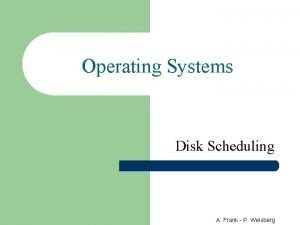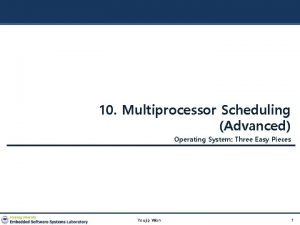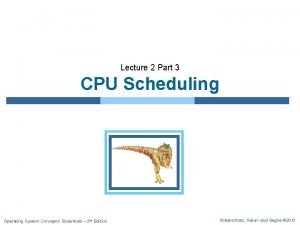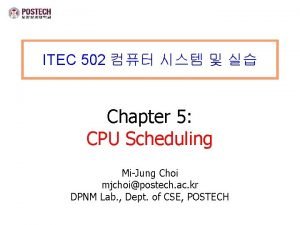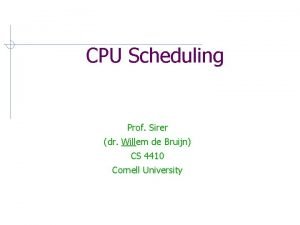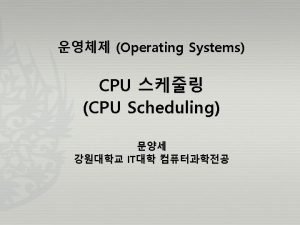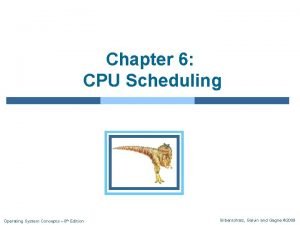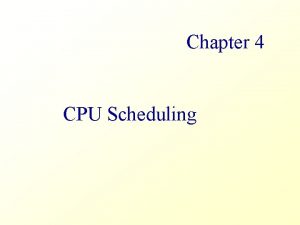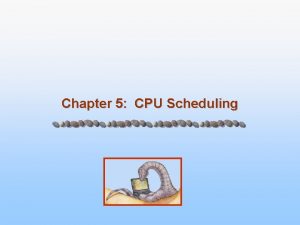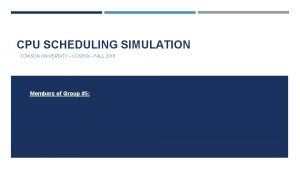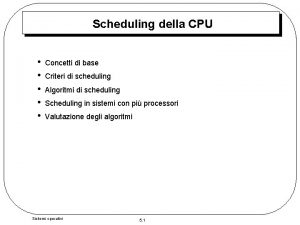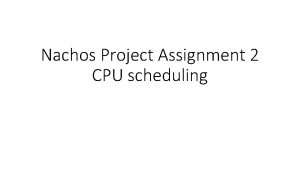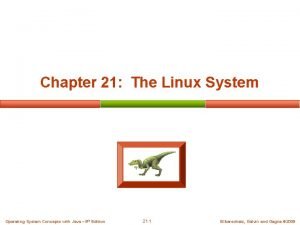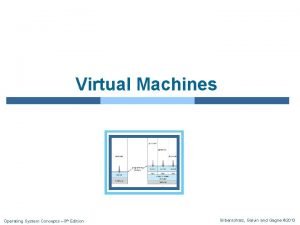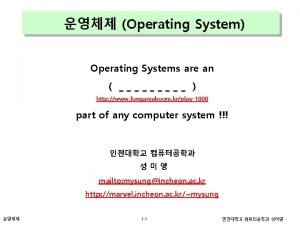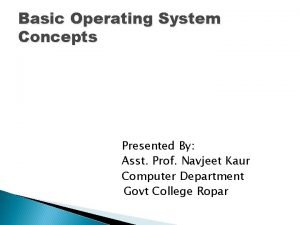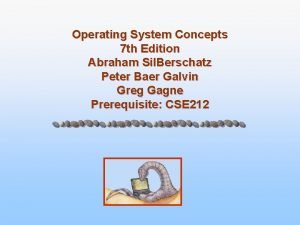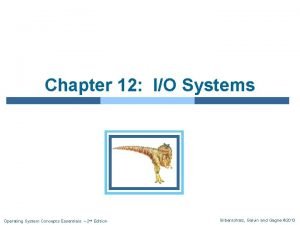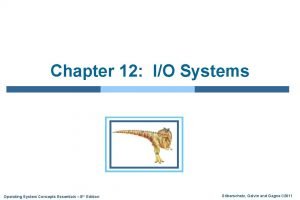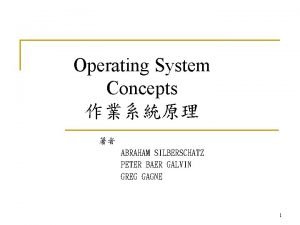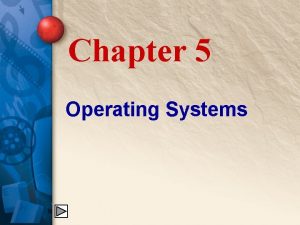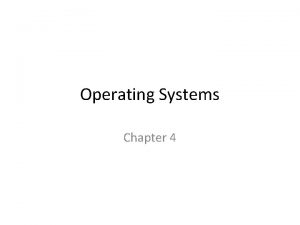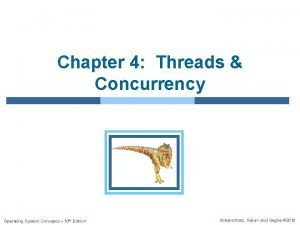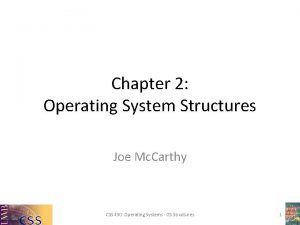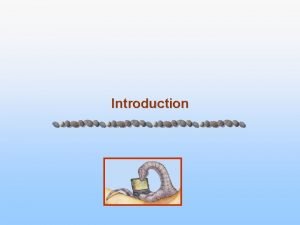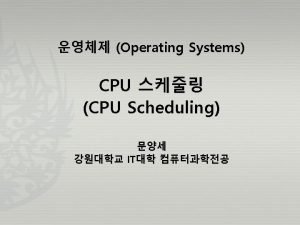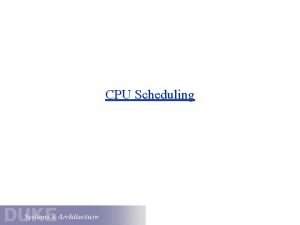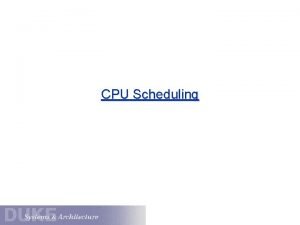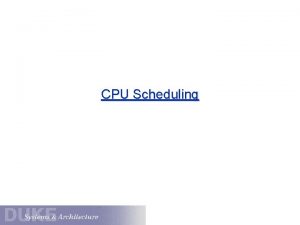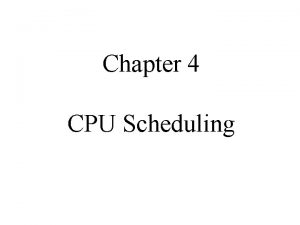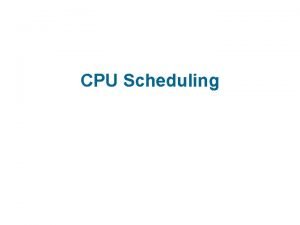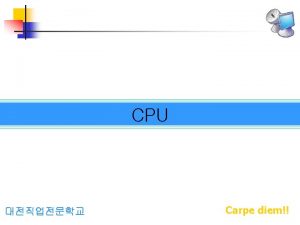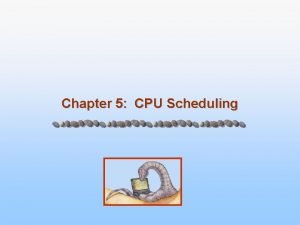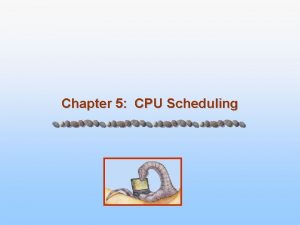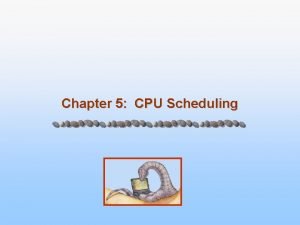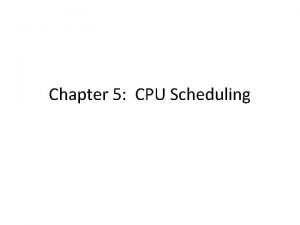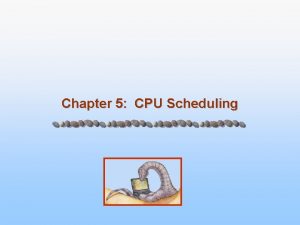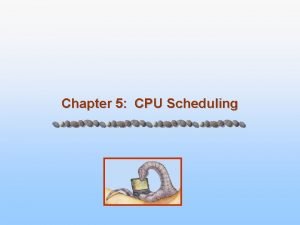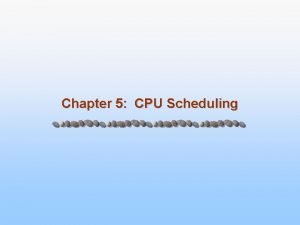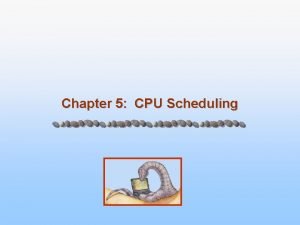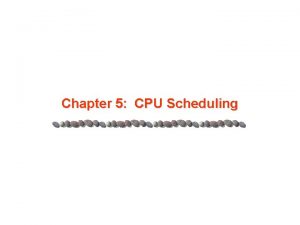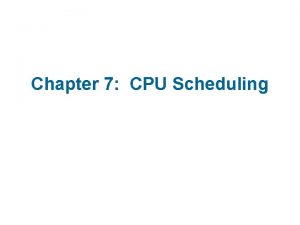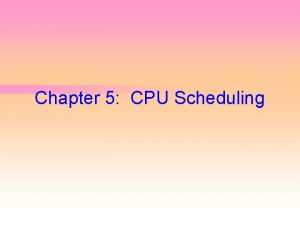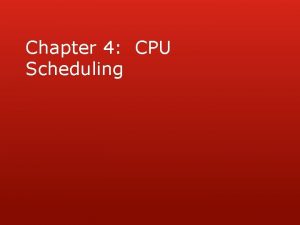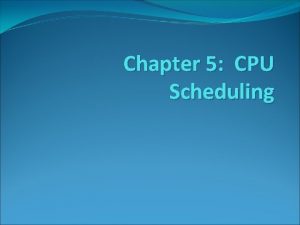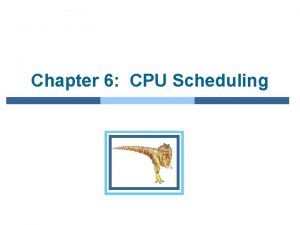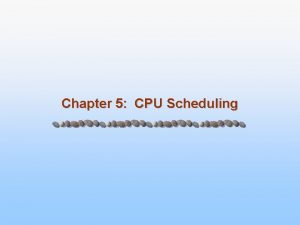Chapter 5 CPU Scheduling Operating System Concepts 8







































- Slides: 39

Chapter 5: CPU Scheduling Operating System Concepts – 8 th Edition Silberschatz, Galvin and Gagne © 2009

Chapter 5: CPU Scheduling Basic Concepts Scheduling Criteria Scheduling Algorithms Thread Scheduling Operating Systems Examples Operating System Concepts – 8 th Edition 5. 2 Silberschatz, Galvin and Gagne © 2009

Objectives To introduce CPU scheduling, which is the basis for multiprogrammed operating systems To describe various CPU-scheduling algorithms To discuss evaluation criteria for selecting a CPU-scheduling algorithm for a particular system Operating System Concepts – 8 th Edition 5. 3 Silberschatz, Galvin and Gagne © 2009

Basic Concepts Maximum CPU utilization obtained with multiprogramming CPU–I/O Burst Cycle – Process execution consists of a cycle of CPU execution and I/O wait CPU burst distribution Operating System Concepts – 8 th Edition 5. 4 Silberschatz, Galvin and Gagne © 2009

Histogram of CPU-burst Times Operating System Concepts – 8 th Edition 5. 5 Silberschatz, Galvin and Gagne © 2009

Alternating Sequence of CPU and I/O Bursts Operating System Concepts – 8 th Edition 5. 6 Silberschatz, Galvin and Gagne © 2009

CPU Scheduler Selects from among the processes in memory that are ready to execute, and allocates the CPU to one of them CPU scheduling decisions may take place when a process: 1. Switches from running to waiting state 2. Switches from running to ready state 3. Switches from waiting to ready 4. Terminates Scheduling under 1 and 4 is nonpreemptive ﻏﻴﺮ ﻭﻗﺎﺋﻲ All other scheduling is preemptive ﻟﺪﻳﻪ ﺣﻖ ﺍﻟﺸﻔﻌﺔ / ﻭﻗﺎﺋﻲ Operating System Concepts – 8 th Edition 5. 7 Silberschatz, Galvin and Gagne © 2009

Dispatcher module gives control of the CPU to the process selected by the short-term scheduler; this involves: switching context switching to user mode jumping to the proper location in the user program to restart that program Dispatch latency – time it takes for the dispatcher to stop one process and start another running Operating System Concepts – 8 th Edition 5. 8 Silberschatz, Galvin and Gagne © 2009

Scheduling Criteria CPU utilization – keep the CPU as busy as possible Throughput – # of processes that complete their execution per time unit Turnaround time – amount of time to execute a particular process Waiting time – amount of time a process has been waiting in the ready queue Response time – amount of time it takes from when a request was submitted until the first response is produced, not output (for timesharing environment) Operating System Concepts – 8 th Edition 5. 9 Silberschatz, Galvin and Gagne © 2009

Scheduling Algorithm Optimization Criteria Max CPU utilization Max throughput Min turnaround time Min waiting time Min response time Operating System Concepts – 8 th Edition 5. 10 Silberschatz, Galvin and Gagne © 2009

First-Come, First-Served (FCFS) Scheduling Process Burst Time P 1 24 P 2 3 P 3 3 Suppose that the processes arrive in the order: P 1 , P 2 , P 3 The Gantt Chart for the schedule is: P 1 P 2 0 24 P 3 27 30 Waiting time for P 1 = 0; P 2 = 24; P 3 = 27 Average waiting time: (0 + 24 + 27)/3 = 17 Operating System Concepts – 8 th Edition 5. 11 Silberschatz, Galvin and Gagne © 2009

FCFS Scheduling (Cont. ) Suppose that the processes arrive in the order: P 2 , P 3 , P 1 The Gantt chart for the schedule is: P 2 0 P 3 3 P 1 6 30 Waiting time for P 1 = 6; P 2 = 0; P 3 = 3 Average waiting time: (6 + 0 + 3)/3 = 3 Much better than previous case Convoy effect short process behind long process Operating System Concepts – 8 th Edition 5. 12 Silberschatz, Galvin and Gagne © 2009

Shortest-Job-First (SJF) Scheduling Associate with each process the length of its next CPU burst. Use these lengths to schedule the process with the shortest time. SJF is optimal – gives minimum average waiting time for a given set of processes The difficulty is knowing the length of the next CPU request. Operating System Concepts – 8 th Edition 5. 13 Silberschatz, Galvin and Gagne © 2009

Example of SJF Process Arrival Time Burst Time P 1 0. 0 6 P 2 2. 0 8 P 3 4. 0 7 P 4 5. 0 3 SJF scheduling chart P 4 0 P 3 P 1 3 9 P 2 16 24 Average waiting time = (3 + 16 + 9 + 0) / 4 = 7 Operating System Concepts – 8 th Edition 5. 14 Silberschatz, Galvin and Gagne © 2009

Determining Length of Next CPU Burst Can only estimate the length Can be done by using the length of previous CPU bursts, using exponential averaging Operating System Concepts – 8 th Edition 5. 15 Silberschatz, Galvin and Gagne © 2009

Prediction of the Length of the Next CPU Burst Operating System Concepts – 8 th Edition 5. 16 Silberschatz, Galvin and Gagne © 2009

Examples of Exponential Averaging =0 n+1 = n Recent history does not count. =1 n+1 = tn Only the actual last CPU burst counts. If we expand the formula, we get: n+1 = tn+(1 - ) tn -1 + … +(1 - )j tn -j + … +(1 - )n +1 0 Since both and (1 - ) are less than or equal to 1, each successive term has less weight than its predecessor. Operating System Concepts – 8 th Edition 5. 17 Silberschatz, Galvin and Gagne © 2009

Priority Scheduling A priority number (integer) is associated with each process The CPU is allocated to the process with the highest priority (smallest integer highest priority) Preemptive ( )ﻭﻗﺎﺋﻲ Nonpreemptive SJF is a priority scheduling where priority is the predicted next CPU burst time Problem Starvation ( – )ﺍﻟﻤﺠﺎﻋﺔ low priority processes may never execute Solution Aging ( – )ﺍﻟﺸﻴﺨﻮﺧﺔ as time progresses increase the priority of the process Operating System Concepts – 8 th Edition 5. 18 Silberschatz, Galvin and Gagne © 2009

Round Robin (RR) Each process gets a small unit of CPU time (time quantum), usually 10 -100 milliseconds. After this time has elapsed, the process is preempted and added to the end of the ready queue. If there are n processes in the ready queue and the time quantum is q, then each process gets 1/n of the CPU time in chunks of at most q time units at once. No process waits more than (n-1)q time units. Performance q large FIFO q small q must be large with respect to context switch, otherwise overhead is too high Operating System Concepts – 8 th Edition 5. 19 Silberschatz, Galvin and Gagne © 2009

Example of RR with Time Quantum = 4 Process Burst Time P 1 24 P 2 3 P 3 3 The Gantt chart is: P 1 0 P 2 4 P 3 7 P 1 10 P 1 14 P 1 18 22 P 1 26 P 1 30 Typically, higher average turnaround than SJF, but better response Operating System Concepts – 8 th Edition 5. 20 Silberschatz, Galvin and Gagne © 2009

Time Quantum and Context Switch Time Operating System Concepts – 8 th Edition 5. 21 Silberschatz, Galvin and Gagne © 2009

Turnaround Time Varies With The Time Quantum Operating System Concepts – 8 th Edition 5. 22 Silberschatz, Galvin and Gagne © 2009

Multilevel Queue Ready queue is partitioned into separate queues: foreground (interactive) background (batch) Each queue has its own scheduling algorithm: foreground – RR background – FCFS Scheduling must be done between the queues: Fixed priority scheduling; (i. e. , serve all from foreground then from background). Possibility of starvation. Time slice – each queue gets a certain amount of CPU time which it can schedule amongst its processes; i. e. , 80% to foreground in RR 20% to background in FCFS Operating System Concepts – 8 th Edition 5. 23 Silberschatz, Galvin and Gagne © 2009

Multilevel Queue Scheduling Operating System Concepts – 8 th Edition 5. 24 Silberschatz, Galvin and Gagne © 2009

Multilevel Feedback Queue A process can move between the various queues; aging can be implemented this way. Multilevel-feedback-queue scheduler defined by the following parameters: number of queues scheduling algorithms for each queue method used to determine when to upgrade a process method used to determine when to demote a process method used to determine which queue a process will enter when that process needs service Operating System Concepts – 8 th Edition 5. 25 Silberschatz, Galvin and Gagne © 2009

Example of Multilevel Feedback Queue Three queues: Q 0 – RR with time quantum 8 milliseconds Q 1 – RR time quantum 16 milliseconds Q 2 – FCFS Scheduling A new job enters queue Q 0 which is served FCFS. When it gains CPU, job receives 8 milliseconds. If it does not finish in 8 milliseconds, job is moved to queue Q 1. At Q 1 job is again served FCFS and receives 16 additional milliseconds. If it still does not complete, it is preempted and moved to queue Q 2. Operating System Concepts – 8 th Edition 5. 26 Silberschatz, Galvin and Gagne © 2009

Multilevel Feedback Queues Operating System Concepts – 8 th Edition 5. 27 Silberschatz, Galvin and Gagne © 2009

Thread Scheduling Distinction between user-level and kernel-level threads Many-to-one and many-to-many models, thread library schedules user -level threads to run on LWP Known as process-contention scope (PCS) since scheduling competition is within the process Kernel thread scheduled onto available CPU is system-contention scope (SCS) – competition among all threads in system Operating System Concepts – 8 th Edition 5. 28 Silberschatz, Galvin and Gagne © 2009

Pthread Scheduling API allows specifying either PCS or SCS during thread creation PTHREAD SCOPE PROCESS schedules threads using PCS scheduling PTHREAD SCOPE SYSTEM schedules threads using SCS scheduling. Operating System Concepts – 8 th Edition 5. 29 Silberschatz, Galvin and Gagne © 2009

Pthread Scheduling API #include <pthread. h> #include <stdio. h> #define NUM THREADS 5 int main(int argc, char *argv[]) { int i; pthread t tid[NUM THREADS]; pthread attr t attr; /* get the default attributes */ pthread attr init(&attr); /* set the scheduling algorithm to PROCESS or SYSTEM */ pthread attr setscope(&attr, PTHREAD SCOPE SYSTEM); /* set the scheduling policy - FIFO, RT, or OTHER */ pthread attr setschedpolicy(&attr, SCHED OTHER); /* create threads */ for (i = 0; i < NUM THREADS; i++) pthread create(&tid[i], &attr, runner, NULL); Operating System Concepts – 8 th Edition 5. 30 Silberschatz, Galvin and Gagne © 2009

Pthread Scheduling API /* now join on each thread */ for (i = 0; i < NUM THREADS; i++) pthread join(tid[i], NULL); } /* Each thread will begin control in this function */ void *runner(void *param) { printf("I am a threadn"); pthread exit(0); } Operating System Concepts – 8 th Edition 5. 31 Silberschatz, Galvin and Gagne © 2009

Operating System Examples Solaris scheduling Windows XP scheduling Linux scheduling Operating System Concepts – 8 th Edition 5. 32 Silberschatz, Galvin and Gagne © 2009

Solaris Dispatch Table Operating System Concepts – 8 th Edition 5. 33 Silberschatz, Galvin and Gagne © 2009

Solaris Scheduling Operating System Concepts – 8 th Edition 5. 34 Silberschatz, Galvin and Gagne © 2009

Windows XP Priorities Operating System Concepts – 8 th Edition 5. 35 Silberschatz, Galvin and Gagne © 2009

Linux Scheduling Constant order O(1) scheduling time Two priority ranges: time-sharing and real-time Real-time range from 0 to 99 and nice value from 100 to 140 (figure 5. 15) Operating System Concepts – 8 th Edition 5. 36 Silberschatz, Galvin and Gagne © 2009

Priorities and Time-slice length Operating System Concepts – 8 th Edition 5. 37 Silberschatz, Galvin and Gagne © 2009

List of Tasks Indexed According to Priorities Operating System Concepts – 8 th Edition 5. 38 Silberschatz, Galvin and Gagne © 2009

End of Chapter 5 Operating System Concepts – 8 th Edition Silberschatz, Galvin and Gagne © 2009
 Operating system concepts chapter 8 solutions
Operating system concepts chapter 8 solutions Operating system concepts chapter 5 solutions
Operating system concepts chapter 5 solutions Operating system concepts chapter 5 solutions
Operating system concepts chapter 5 solutions Disk scheduling in operating system
Disk scheduling in operating system Multiprocessor scheduling in os
Multiprocessor scheduling in os Turnaround time in os
Turnaround time in os Priority scheduling
Priority scheduling Sjf cpu scheduling
Sjf cpu scheduling Fcfs gantt chart
Fcfs gantt chart Cpu i/o
Cpu i/o Sjf cpu scheduling
Sjf cpu scheduling In cpu scheduling the clock is of type
In cpu scheduling the clock is of type Preeptive
Preeptive Cpu scheduling project
Cpu scheduling project Scheduling della cpu
Scheduling della cpu Cpu scheduling project
Cpu scheduling project Sjn scheduling
Sjn scheduling Operating system
Operating system Linux operating system concepts
Linux operating system concepts Operating system concepts with java
Operating system concepts with java Operating system concepts 6th edition
Operating system concepts 6th edition Operating system concepts 9
Operating system concepts 9 Realtime operating system
Realtime operating system 교보 drm
교보 drm Basic concepts of os
Basic concepts of os Operating system concepts 11th
Operating system concepts 11th Operating system concepts essentials
Operating system concepts essentials Operating system concepts essentials
Operating system concepts essentials Silberschatz operating system concepts
Silberschatz operating system concepts Operating systems
Operating systems Buddy system operating system
Buddy system operating system File system in operating system
File system in operating system File system in operating system
File system in operating system File system in operating system
File system in operating system 5 operating systems
5 operating systems Operating system history
Operating system history Chapter 4 operating system
Chapter 4 operating system Concurrency vs parallelism in os
Concurrency vs parallelism in os Windows operating system architecture
Windows operating system architecture What operating system is this
What operating system is this



